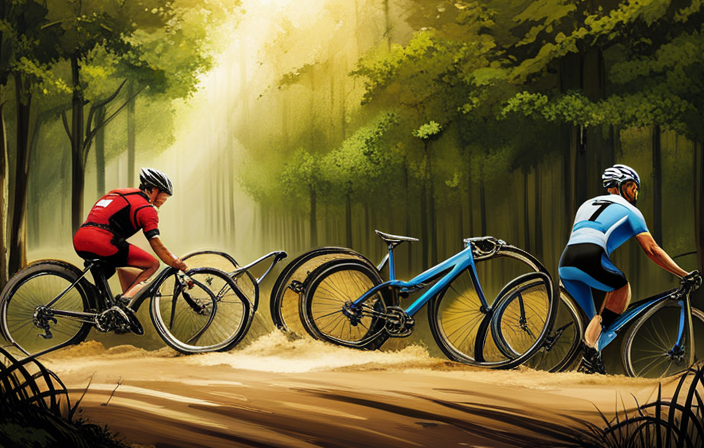Are you currently shopping for a new bike, but finding it difficult to decide between a gravel bike and a cyclocross bike?
Don’t worry, I’ve got you covered! In this article, we’ll delve into the key differences between these two popular types of bikes.
From frame geometry to tire clearance, brake systems to racing capabilities, we’ll explore it all.
By the end of this piece, you’ll have a clear understanding of which bike is best suited for your needs and preferences.
Let’s dive in!
Key Takeaways
- Gravel bikes are designed for off-road adventures and can handle various terrains, while cyclocross bikes are primarily used for racing on off-road courses with obstacles.
- Gravel bikes have longer wheelbases and a more relaxed geometry for stability and comfort, while cyclocross bikes have shorter wheelbases and a steeper geometry for nimble maneuvering in races.
- Gravel bikes have more tire clearance for wider tires, providing better traction and stability on rough terrain, while cyclocross bikes have narrower tire clearance for mud shedding during races.
- Both gravel and cyclocross bikes commonly use disc brakes for superior stopping power and consistent performance, although rim brakes are lighter and easier to maintain.
Definition and Purpose of a Gravel Bike
A gravel bike is designed for off-road adventures and can handle a variety of terrains, making it perfect for riders seeking versatility in their cycling experience. One of the advantages of a gravel bike is its ability to tackle both paved roads and rough trails with ease. With wider tires and a more relaxed geometry compared to road bikes, gravel bikes provide stability and comfort on uneven surfaces. They also typically come equipped with disc brakes for better stopping power in all conditions.
There are several popular gravel bike models on the market today. The Specialized Diverge, Trek Checkpoint, and Cannondale Topstone are just a few examples that offer excellent performance and durability. These bikes often feature lightweight frames made from materials like carbon fiber or aluminum, ensuring efficiency without compromising strength.
Now let’s transition to the definition and purpose of a cyclocross bike.
Definition and Purpose of a Cyclocross Bike
The primary use of a cyclocross bike is for racing on off-road courses that involve obstacles such as mud, sand, and steep hills. Cyclocross bikes are designed to be lightweight yet durable, with features that allow for quick maneuvering and easy shouldering when navigating through challenging terrains. They typically have wider tire clearance to accommodate the mud and debris encountered during races.
Pros of using a cyclocross bike include its versatility – it can be used not only for racing but also for commuting or touring. The aggressive geometry provides a more upright riding position, making it easier to handle in technical sections. Furthermore, the disc brakes offer excellent stopping power even in wet conditions.
Comparatively, gravel bikes share some similarities with cyclocross bikes. Both types of bikes have drop handlebars and wider tires compared to road bikes. However, gravel bikes are designed with longer wheelbases and slacker head tube angles, which provide stability over long distances on mixed surfaces.
Transitioning into the subsequent section about frame and geometry differences: Now that we understand the purpose of a cyclocross bike, let’s explore how its frame and geometry differ from those of a gravel bike.
Frame and Geometry Differences
When considering frame and geometry, you’ll notice distinct variations between gravel bikes and cyclocross bikes. These differences are important to understand because they directly impact the performance and handling of each bike.
One key difference is in the bike frame design. Gravel bikes typically have a longer wheelbase compared to cyclocross bikes. This provides more stability and comfort for long rides on varying terrain. On the other hand, cyclocross bikes have a shorter wheelbase, which makes them more nimble and maneuverable for quick turns and tight corners during races.
Another variation lies in the geometry of the two types of bikes. Gravel bikes often have a more relaxed geometry with a slacker head tube angle, which enhances stability at higher speeds. Cyclocross bikes, however, have a steeper head tube angle that allows for quicker steering response.
These frame and geometry differences greatly influence how each bike handles different terrains and riding conditions. Understanding these distinctions can help riders choose the most suitable bike for their specific needs.
Moving on to tire clearance and width…
Tire Clearance and Width
Tire clearance and width greatly impact the performance of both gravel and cyclocross bikes. When it comes to tire clearance, gravel bikes typically have more room than cyclocross bikes. This allows for wider tires, which provide better traction, stability, and comfort on rough terrain. Cyclocross bikes, on the other hand, have narrower tire clearance to prioritize mud shedding during races.
Choosing the right tire width depends on the terrain you’ll be riding on. Here are three key considerations:
1) Pros and cons of different tire widths: Wider tires (above 40mm) offer increased traction and a smoother ride over rough surfaces. However, they can be slower on paved roads due to increased rolling resistance. Narrower tires (around 30mm) are faster on pavement but may lack grip in looser conditions.
2) Choosing the right tire for different terrain: For gravel riding with loose or muddy surfaces, wider tires with aggressive tread patterns are recommended for better grip. For cyclocross racing that involves mostly compacted dirt or grass, narrower tires with less aggressive tread can provide greater speed.
3) Transitioning to ‘brake systems’: While tire choice plays a significant role in bike performance, another important factor is the brake system used.
By considering these factors along with your riding style and preferences, you can choose the optimal tire width for your needs. Now let’s move on to discussing brake systems…
Brake Systems
To optimize your riding experience, you should consider the type of brake system that best suits your needs. When it comes to gravel and cyclocross bikes, there are different types of brake systems available. The two main options are disc brakes and rim brakes.
Disc brakes have become increasingly popular in off-road cycling for their superior stopping power and consistent performance in all weather conditions. They use a rotor attached to the wheel hub and calipers that squeeze the rotor to slow down or stop the bike. This design provides reliable braking even in wet or muddy conditions, making them ideal for gravel and cyclocross riding.
On the other hand, rim brakes are the traditional choice for road cycling but can still be found on some cyclocross bikes. They work by squeezing brake pads against the sides of the rim to create friction and slow down or stop the bike. While they are lighter than disc brakes, they may not offer as much stopping power, especially in adverse weather conditions.
Both disc brakes and rim brakes have their pros and cons. Disc brakes provide better modulation, meaning you can apply just the right amount of braking force needed without locking up your wheels easily. However, they tend to be slightly heavier than rim brakes due to additional components such as rotors and calipers.
Rim brakes, on the other hand, are generally lighter and easier to maintain since they don’t require hydraulic lines or fluid like disc brakes do. However, they may suffer from reduced performance when wet or muddy conditions prevail.
When considering which brake system is best for you, it’s important to weigh factors such as your riding style, terrain preferences, maintenance requirements, and budget constraints.
Transitioning into our next section about gearing options…
Gearing Options
Consider your preferred gearing options to optimize your riding experience on gravel and cyclocross bikes. When it comes to gearing, both types of bikes offer a range of options to suit different terrains and riding styles. Here are three key factors to consider:
-
Gearing ratios: Gravel bikes typically have a wider range of gears compared to cyclocross bikes. This is because gravel biking often involves tackling steep climbs and rough terrain, requiring lower gears for easier pedaling. Cyclocross bikes, on the other hand, prioritize quick acceleration and speed over varied terrain.
-
Gear range: The gear range refers to the difference between the highest and lowest gears available. Gravel bikes tend to have a wider gear range, allowing riders to tackle both challenging climbs and fast descents with ease. Cyclocross bikes usually have a narrower gear range since they are designed for shorter races with less emphasis on extreme terrain.
-
Terrain compatibility: Consider the type of terrain you will be riding on most frequently when choosing your gearing options. If you plan on tackling steep off-road trails or long-distance rides with varied elevation, a gravel bike’s wider gear range may be more suitable. However, if you primarily ride on flat or smooth surfaces or participate in short cyclocross races, a cyclocross bike’s narrower gear range may be sufficient.
So now that we’ve covered gearing options, let’s dive into the next section about suspension features without missing a beat!
Suspension Features
When it comes to suspension features, it’s important to think about the type of terrain you’ll be riding on and how much comfort and control you desire. Suspension can greatly impact your riding experience, especially when comparing gravel bikes and cyclocross bikes.
Gravel bikes are designed for a mix of off-road and on-road riding, often on rougher terrains. They typically have suspension features that provide some level of cushioning to absorb bumps and vibrations. This helps to improve comfort and control, allowing riders to navigate uneven surfaces with more ease. On the other hand, cyclocross bikes are primarily built for racing on smooth off-road courses. These bikes usually do not have suspension features as they prioritize speed and agility over comfort.
To illustrate the key differences between suspension options for gravel and cyclocross bikes, consider the following table:
| Gravel Bike | Cyclocross Bike | |
|---|---|---|
| Suspension Type | Front/Rear | Rigid |
| Purpose | Comfort/Control | Speed/Agility |
| Suitable Terrain | Mixed | Off-road Courses |
Considering these factors will help you choose the right bike based on your preferred style of riding. Moving forward into our discussion about weight and agility in the next section…
Weight and Agility
If you’re looking for a bike that is lightweight and nimble, you’ll want to focus on the weight and agility of the options available. When comparing gravel bikes and cyclocross bikes, one key difference lies in their weight vs. stability trade-off.
Gravel bikes tend to be slightly heavier than cyclocross bikes due to their additional features like larger tires, more relaxed geometry, and extra mounts for accessories. This added weight provides better stability when riding over rough terrain or long distances, making it a preferred choice for endurance rides or bikepacking adventures.
On the other hand, cyclocross bikes prioritize maneuverability over control by being lighter and more agile. They are designed with racing in mind and feature a more aggressive geometry that allows riders to navigate tight corners and obstacles with ease. The reduced weight also makes them quicker off the line during sprints or steep climbs.
Transitioning into the subsequent section about ‘riding position and comfort,’ it’s worth noting that while weight and agility play important roles in choosing between gravel bikes and cyclocross bikes, they are not the only factors to consider. The next aspect to examine is how these two types of bikes differ in terms of riding position and comfort.
Riding Position and Comfort
To ensure a comfortable ride, it’s important to pay attention to the riding position and how it feels on your body. There are some differences in riding positions between gravel bikes and cyclocross bikes that can affect your comfort.
Firstly, let’s talk about saddle position. Both gravel bikes and cyclocross bikes generally have a more upright riding position compared to road bikes. However, gravel bikes tend to have a slightly more relaxed and comfortable saddle position than cyclocross bikes. This is because gravel biking often involves longer rides on rougher terrain, so having a more comfortable saddle position can help reduce fatigue.
Secondly, handlebar options also play a role in the riding position and comfort of these bikes. Gravel bikes usually come with drop handlebars that provide multiple hand positions for long rides. On the other hand, cyclocross bikes typically have flatter handlebars for better control during off-road racing.
Considering both the saddle position and handlebar options will help you find the right bike that suits your preferred riding style and body comfort.
Now let’s transition into discussing terrain compatibility between gravel bikes and cyclocross bikes.
Terrain Compatibility
Consider the terrain you plan to ride on to determine which bike is more compatible for your needs. When it comes to off-road capabilities, both gravel bikes and cyclocross bikes excel in handling rough terrains. However, there are some slight differences that may sway your decision.
Gravel bikes are designed with a slightly more relaxed geometry, making them ideal for long-distance rides on mixed surfaces. They offer stability and control, allowing you to tackle uneven terrain with ease. With wider tires and lower bottom brackets, gravel bikes provide a comfortable and forgiving ride over gravel roads, dirt paths, and even light trails.
On the other hand, cyclocross bikes are built specifically for racing in challenging conditions. They have a more aggressive geometry that offers quick handling and nimble maneuverability. Cyclocross bikes feature higher bottom brackets to prevent pedal strikes during tight turns or obstacles. This makes them perfect for navigating through muddy courses or tackling steep inclines.
Transitioning into the next section about versatility and multi-surface performance, it’s important to note that both gravel bikes and cyclocross bikes are highly versatile machines that can handle various terrains with ease.
Versatility and Multi-Surface Performance
Now that we have discussed the terrain compatibility of gravel bikes and cyclocross bikes, let’s delve into another important aspect: versatility and multi-surface performance.
One of the key reasons why gravel bikes have gained tremendous popularity in recent years is their ability to handle a wide range of surfaces and riding conditions. Gravel bikes are designed to excel in various scenarios, making them suitable for bikepacking adventures as well as gravel racing. With their wider tires, relaxed geometry, and more comfortable riding position compared to traditional road bikes, they offer a smooth and stable ride on rough terrains like dirt roads or gravel paths. This makes them an excellent choice for long-distance touring or exploring off-the-beaten-path routes.
In contrast, while cyclocross bikes are also versatile, they are primarily built for short-duration races on intense cyclocross courses. They tend to be more aggressive in terms of geometry and have narrower tires than gravel bikes. As a result, they may not perform as well on rougher terrains or during longer rides.
It’s worth mentioning that although gravel bikes share some similarities with mountain bikes due to their off-road capabilities, they are still distinct from each other in terms of design and purpose. Gravel bikes prioritize efficiency over technical prowess, making them better suited for covering long distances at higher speeds compared to mountain bikes.
Transitioning into the next section about competitive use and racing capabilities…
Competitive Use and Racing Capabilities
When it comes to competitive use and racing capabilities, you’ll find that gravel bikes and cyclocross bikes have their own unique strengths. While both bikes are designed for off-road riding, they excel in different areas when it comes to racing.
For competitive cyclocross racing, the bikes are specifically built with features that enhance maneuverability and quick handling on tight courses. They have a more aggressive geometry, allowing riders to navigate sharp turns and obstacles with ease. Cyclocross races often involve dismounting and carrying the bike over barriers or muddy sections, so these bikes are lightweight and easy to shoulder.
On the other hand, gravel bikes are better suited for long-distance endurance races on mixed terrain. Their relaxed geometry provides stability and comfort during long hours in the saddle. Gravel races typically involve long stretches of gravel roads with varying degrees of roughness, so these bikes have wider tires for improved traction.
To excel in either type of race, specific techniques and training strategies must be employed. Cyclocross racers focus on dismounting quickly, shouldering the bike efficiently, and remounting smoothly. Gravel racers concentrate on maintaining a steady pace while managing energy levels for long distances.
Transitioning into the next section about price range and affordability: As we delve into the differences between gravel bikes and cyclocross bikes in terms of price range and affordability…
Price Range and Affordability
Gravel bikes and cyclocross bikes vary in terms of their price range and affordability. When it comes to price comparison, gravel bikes tend to be more expensive than cyclocross bikes. This is mainly because gravel bikes are designed for versatility and durability, which often requires higher quality components. However, the price range can still vary depending on the brand and specific features of the bike.
There are several brand options available for both gravel bikes and cyclocross bikes. Popular brands like Specialized, Trek, Giant, and Cannondale offer a wide range of models at different price points. These brands have established themselves as reliable manufacturers in the cycling industry, ensuring that you’re getting a quality product for your investment.
Maintaining a gravel bike or a cyclocross bike also plays a role in its overall affordability. Regular maintenance is crucial to keep these bikes running smoothly and prolong their lifespan. While maintenance costs may add up over time, it’s important to consider the long-term benefits of investing in a well-maintained bike.
Transitioning into the subsequent section about maintenance and durability, it’s essential to understand how these factors contribute to the overall value of both gravel bikes and cyclocross bikes.
Maintenance and Durability
To ensure your bike lasts for years, it’s important to understand the maintenance and durability of both types.
When it comes to maintenance tips, both gravel bikes and cyclocross bikes require regular cleaning and lubrication of the drivetrain, as well as routine inspections of the brakes, tires, and suspension. However, due to their different purposes, there are some variations in maintenance.
Gravel bikes tend to accumulate more dirt and mud during off-road rides, so it’s crucial to clean them thoroughly after each ride to prevent any damage or corrosion. On the other hand, cyclocross bikes are designed for intense racing conditions which can put a strain on components like the chainrings and bottom bracket. Regular checks for wear and tear are essential in order to catch any issues early on.
In terms of durability, both types of bikes are built with robust frames and components that can withstand rough terrains. However, there are some common issues that riders may encounter.
For gravel bikes, flat tires due to sharp rocks or thorns can be a recurring problem. Investing in puncture-resistant tires is a good idea for added durability. As for cyclocross bikes, frequent crashes during races can lead to bent derailleur hangers or damaged wheels. It’s important to have these parts checked after such incidents.
Transition: Now that we’ve discussed maintenance tips and common issues with both types of bikes, let’s move on to choosing the right bike for your needs and preferences without overlooking any details about performance or comfort factors.
Choosing the Right Bike for Your Needs and Preferences
Deciding on the ideal bike for your specific requirements and preferences can be a challenging task. When it comes to choosing between a gravel bike and a cyclocross bike, understanding their differences is crucial. One important aspect to consider is bike fit. Both types of bikes have slightly different geometries that affect how you feel while riding. Gravel bikes typically have a more relaxed geometry, offering a more comfortable riding position for longer distances. On the other hand, cyclocross bikes are designed with a more aggressive geometry, allowing for better maneuverability and control in off-road conditions.
Another factor to consider is brand reputation. Different brands offer varying levels of quality and reliability. It’s important to do your research and choose a reputable brand known for producing durable and high-performing bikes. Reading reviews from other cyclists can provide valuable insights into each brand’s strengths and weaknesses.
To help you visualize the differences between gravel bikes and cyclocross bikes, here’s a table comparing some key features:
| Feature | Gravel Bike | Cyclocross Bike |
|---|---|---|
| Geometry | Relaxed | Aggressive |
| Tire Clearance | Wide | Narrow |
| Brake Type | Disc | Cantilever or disc |
| Frame Material | Carbon or aluminum | Aluminum |
| Use Case | Long distance on mixed terrain | Off-road racing |
By considering factors such as bike fit and brand reputation, you can make an informed decision when choosing between a gravel bike and a cyclocross bike that aligns with your needs and preferences.
Frequently Asked Questions
Can I use a cyclocross bike for long-distance rides on paved roads?
Yes, a cyclocross bike can be used for long-distance rides on paved roads. While it is designed for off-road racing, its versatility makes it suitable for city commuting as well.
The lightweight frame and agile handling make it easy to navigate through traffic. However, if you’re looking for a more comfortable and stable option for touring trips, a gravel bike would be better suited with its relaxed geometry and wider tires providing a smoother ride over longer distances.
Can I use a gravel bike for competitive cyclocross races?
Absolutely!
While a gravel bike can handle the demands of competitive cyclocross racing, there are definite advantages to using a dedicated cyclocross bike.
The lighter frame and more aggressive geometry make for nimble handling on technical courses. Additionally, the higher bottom bracket clearance and stiffer frame provide better power transfer during those intense sprints and climbs.
So while a gravel bike can hold its own, a specialized cyclocross bike will give you that extra edge in the race.
Are gravel bikes more comfortable than cyclocross bikes for longer rides?
Gravel bikes are generally more comfortable than cyclocross bikes for longer rides. They have a more relaxed geometry, wider tires, and often come with features like suspension or vibration-damping technologies.
This makes them better suited for absorbing bumps and vibrations on rough terrain, providing a smoother and more enjoyable ride over long distances.
Cyclocross bikes, on the other hand, prioritize speed and agility for shorter races, which can result in a less comfortable experience on longer rides.
Are cyclocross bikes more durable than gravel bikes?
Investigating the truth of the theory that cyclocross bikes are more durable than gravel bikes, it is important to consider the advantages of cyclocross bikes.
Cyclocross bikes are designed for off-road racing and have features like a strong frame, sturdy wheels, and aggressive tires. These qualities make them highly durable and capable of withstanding rough terrains and harsh conditions.
On the other hand, while gravel bikes may not be as rugged as cyclocross bikes, they still offer a good level of durability for gravel riding.
Can I use a cyclocross bike for off-road adventures and bikepacking trips?
Yes, you can definitely use a cyclocross bike for off-road adventures and bikepacking trips.
Cyclocross bikes are designed to handle rough terrain and challenging conditions, making them ideal for off-road biking. They have wider tires with more tread, which provide better traction on dirt and gravel surfaces.
Additionally, cyclocross bikes often come with features like disc brakes and higher clearance to accommodate larger tires, further enhancing their off-road capabilities.
Conclusion
In conclusion, understanding the difference between a gravel bike and a cyclocross bike is essential when choosing the right bike for your needs.
While both bikes share similarities in terms of their off-road capabilities, there are distinct differences in frame geometry, tire clearance, brake systems, and racing capabilities.
One interesting statistic to note is that according to a recent survey, the gravel bike market has seen a significant growth of 54% in the past year alone. This shows the increasing popularity and demand for these versatile bikes among cyclists.
So whether you’re looking to explore new terrains or take on challenging races, make sure to consider these differences and choose accordingly.









